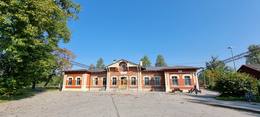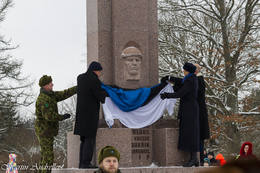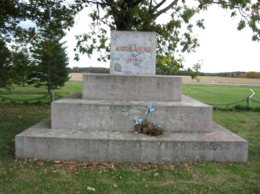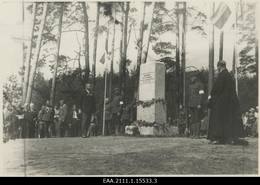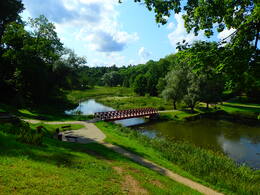Nepriklausomybės karo proveržiai: čia ir ne toliau
I Nepriklausomybės karai
Lemiami Nepriklausomybės karo mūšiai įvyko 1919 m. sausio ir vasario mėnesiais, priversdami Raudonąją armiją trauktis iš Estijos.
1918 m. lapkričio 28 d. Sovietų Rusija pradėjo puolimą prieš Estiją, pradėdama Nepriklausomybės karą. Visą gruodį Raudonoji armija sparčiai žygiavo Estijoje. Po vieną bolševikų kontroliuojami buvo Jehvio, Kundos, Rakverės, Tapos ir Aegviidu miestai Šiaurės Estijoje ir Veru, Valgos, Tartu, Tervos ir Mõisakülos miestai Pietų Estijoje. 1919 m. sausio mėn. Raudonoji armija buvo vos už 40 km nuo Talino.
Po beveik dviejų mėnesių atsitraukimo Estijos armija sutelkė jėgas kovai. 1918 m. gruodį vyriausioji ginkluotųjų pajėgų vadovybė buvo užsiėmusi armijos organizavimu. Jie vykdė masinį šaukimą į kariuomenę ir išsiuntė naujus dalinius į mūšio frontą. Britų karališkojo laivyno eskadrilės ir suomių savanorių atvykimas į Taliną padėjo pakeisti karo su sovietais eigą. Sąjungininkų prieš Sovietų Rusiją turėjimas sustiprino kareivių ir civilių moralę. 1919 m. sausio pradžioje įvykęs lūžis sustabdė sovietų puolimą, o iniciatyvą perėmė estai.
Iki 1919 m. sausio 5 d. buvo mobilizuota 14 000 vyrų, o Estijos pajėgos pradėjo kontrpuolimą. Sausio 19 d. buvo išlaisvintas Narvos miestas, nustumiant fronto liniją atgal palei Narvos upę. 1919 m. sausio 14 d. jungtinės plačiųjų šarvuočių ir leitenanto Kuperjanovo vadovaujamo partizanų pulko pajėgos išlaisvino Tartu miestą. Vasario 1 d. per mirtiną Padžu mūšį buvo išlaisvintas Valgos miestas, o vasario 3 d. – Veru. 1. Kontradmirolo Johano Pitkos vadovaujami jūrų pėstininkai Suomijos įlankos pakrantėje sukėlė paniką Raudonosios armijos kariuomenės užnugaryje.
1919 m. vasario 24 d., praėjus metams po Estijos nepriklausomybės paskelbimo, Estijos ginkluotųjų pajėgų vyriausiasis vadas generolas Johanas Laidoneris pranešė Estijos provincijos asamblėjai, kad priešas nustumtas už Estijos sienų. Estija buvo išlaisvinta per mažiau nei du mėnesius.
Susijusios vietos
Kehros muziejus – Kehros stoties nevyriausybinė organizacija
Šis privatus muziejus, atidarytas 2018 m., įsikūręs istorinėje XIX a. pabaigos geležinkelio stotyje.
Joje eksponuojami lemiami Nepriklausomybės karo mūšiai, vykę netoli Kehros 1919 m. pradžioje. Pati stotis 1919 m. pradžioje tarnavo kaip karinis štabas, čia buvo dislokuoti šarvuočiai, o iš čia buvo vedama mūšių serija, nuo kurios prasidėjo Estijos puolimas į pergalę.
Kehros mūšio paminklas
1919 m. sausio 4 d. įvykęs Kehros mūšis buvo pirmoji sėkminga šarvuočių puolimo ataka ir lūžio taškas Nepriklausomybės kare, sustabdęs sovietų puolimą Talino link. Pasak legendos, atvykęs į šią vietą generolas Laidoneris asmeniškai pareikalavo pažymėti mūšio lauką. Šis paminklas buvo paskutinis, užbaigtas iki Antrojo pasaulinio karo. Jis niekada nebuvo oficialiai atidengtas – 1940 m. birželio 23 d. turėjusi įvykti atidengimo ceremonija buvo atšaukta dėl sovietų pajėgų invazijos. 6,5 metro aukščio paminklas buvo susprogdintas 1944 m. pabaigoje (nors kai kurie šaltiniai teigia, kad tai įvyko dar 1940 m.), o jo akmeniniai blokai buvo panaudoti netoliese esančių vasarnamių statybai. Geležinkelio stotelė prie paminklo, kuri nepriklausomybės laikais buvo pavadinta Lahinguvälja (Mūšio laukas), 1957 m. sovietų režimo buvo pervadinta į Vikipalu. Atkūrus nepriklausomybę, stotelei buvo suteiktas pirminis pavadinimas. Paminklas buvo restauruotas mažesniu pavidalu, panaudojant išlikusias originalo dalis, ir atidengtas 2000 m. birželio 23 d. Atkurtas originalia forma, jis iš naujo atidengtas 2019 m. sausio 6 d., minint Estijos Respublikos šimtmetį. Koloną puošia kareivio veido reljefas ir užrašas: „Čia buvo sustabdytas priešo puolimas ir taip prasidėjo mūsų pajėgų žygis į pergalę 1919 m. sausio 4 d.“.
Pergalės altorius Aidu mieste
Pergalės altorius yra šalia buvusios pieninės Vaadu ūkyje Aidu miestelyje, prie Jõgevos–Põltsamaa kelio.
Tai Nepriklausomybės karo paminklas. Šis paminklas žymi tolimiausią Raudonosios armijos kareivio žygio tašką.
Eduardo Järve suprojektuotas paminklas buvo atidengtas 1929 m. birželio 23 d. 1932 m. šalia paminklo buvo pasodinti du ąžuolai, vienas iš jų išliko. 1934 m. sausio 4 d. 2-asis pėstininkų batalionas Tartu Lembitu kareivinių aikštėje persodino iš Aidu atvežtą ąžuolą Aidu mūšio garbei.
1934 m. sausio 4 d. 2-asis pėstininkų batalionas Aidu mūšyje išrovė vieną iš ąžuolų ir atsodino jį aikštėje priešais Lembitu kareivines Tartu mieste, Aidu mūšio atminimui. Paminklas buvo susprogdintas 1940 m., o visiškai sunaikintas 1965 m. Dabartinė originalaus paminklo kopija buvo atidengta 1989 m. birželio 23 d.
Reolos mūšio paminklas
Šis paminklas yra Tõõraste kaime, Kastre savivaldybėje. Jį suprojektavo Antonas Sobolevas, jis skirtas Reolos mūšiui, kuris buvo vienas iš lūžio taškų Nepriklausomybės kare. Šio mūšio, vykusio 1919 m. sausio 16 ir 17 d., metu Estijos pajėgos sužlugdė Raudonosios armijos bandymą užimti Tartu. Paminklas buvo atidengtas 1932 m. liepos 3 d. Po Antrojo pasaulinio karo jis buvo nugriautas ir užkastas. 1988 m. lapkričio 27 d. paminklas, dabar iškastas ir restauruotas Kambjos paveldo asociacijos, buvo atidengtas iš naujo.
Misiņkalno karinio paveldo takas
Misinkalno gamtos parkas yra Aizputės mieste. Misinkalnas yra aukščiausia Aizputės miesto vieta. Jo aukštis siekia 95,4 m. Nuo viršūnės atsiveria vaizdingas miesto vaizdas. Misinkalno gamtos parkas iš pradžių pradėtas kurti XX a. Šiuo metu parko plotas yra apie 28 ha.
Parko teritorijoje yra kelios vietos ir memorialai, susiję su XX amžiaus įvykiais – Latvijos laisvės karuose žuvusių karių – Lačplėšo ordino kavalerių – memorialinė stela, Holokausto memorialo vieta, represuotųjų atminimo vieta ir žuvusių raudonųjų partizanų memorialinė lenta.
Parke galima susipažinti su įvairių retų rūšių augalais ir plantacijomis, taip pat mėgautis nepaliesta gamta. Šiuo metu parką raižo atnaujinti pėsčiųjų ir dviračių takai, o parko teritorijoje yra motociklų trasa, kurioje vyksta Latvijos motokroso varžybos.
Norint išsamiau pažinti Misiņkalno dvaro parko kultūrinį ir istorinį paveldą, rekomenduojame pasinaudoti gido paslaugomis.
Susijusi istorija
Aizporių dvaras Nepriklausomybės kovų metu
Aizporų pusdvaras, Aizputės rajonas, Kalvenės savivaldybė, yra vakariausia Latvijos vieta, į kurią atsitraukė pulkininko Oskaro Kalpako atskirasis batalionas.
Pusiaukelėje tarp Rudbāržių ir Kalvenės, pakelėje, yra Aizporės kapinės. Jose stovi paminklas ir 12 atminimo ženklų Oskaro Kalpakos bataliono savanoriams kariams.





